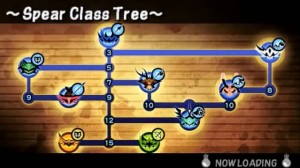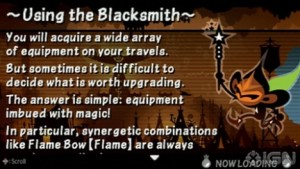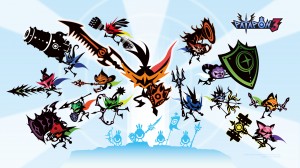Lens of Economy
There are 3 basic types of “currency” in Patapon 3 – Ka-ching, Materials and Equipment. These 3 are used to upgrade the gear of your 4 men “army”. All 3 of them are earned through clearing stages (most of which are repeatable) and every stage has at least 1 treasure chest which gives a prize, usually an equipment. The stages can be cleared in a short amount of time and relatively easily. Storyline bosses may take longer (2 to 3 stages which must be cleared at 1 shot). Clearing the storyline increases difficulty as well as the rank of the items that can be obtained. These 3 resources are used to upgrade the obtained equipment at the blacksmith. Some materials and equipment become randomly purchasable from an NPC after an early part of the storyline. Farming can hence be monotonous by repeating a few stages, but there is a variety to choose from. Fortunately those are not the only type of “currency” and also grow with farming. Patapon 3 has a levelling system, a typical trait in many games. Levelling makes your army stronger, as well as unlocking different classes and set skills. Patapon 3 has two types of skills and levelling methods instead. The first is set skills which are associated with certain jobs and unlocked at certain levels. For example, Allosson (the stronger version of a bow user) has a set skill which creates a tailwind while Fever Mode is activated, increasing his range while reducing that of your enemies (and defending your army from spore-type attacks). These set skills can be equipped by the Patapon before beginning a stage, and you are free to mix and match them (The maximum number of set skills equippable depends on the class). Patapon also has class skills which are passive. These are levelled by repeated use, which may empower a class as well as its related branch-classes. How does throwing 4 spears instead of 1 sound?
Lens of Skill
Patapon 3, like its predecessors, is a rhythm game with some elements of RTS. Hence this game actually requires a few skills – a little “music” sense, thumb-movement (in my case, I use my thumb), tactics in choosing your line-up and battle process (selection of skills, equipment, miracles etc), decision-making (when to use the said skills) and ability to keep calm while not jumbling your fingers. The commands are issued to your “army” in the form of 4 drumbeats, getting a perfect timing for the beats will grant several advantages like being able to invoke your Uberhero’s skill (in “FEVER Mode”). Giving perfectly timed commands also speeds up charging to “FEVER Mode” when The other members of your army also gain bonuses like stronger attack or defense, and even activate some passive skills known as set skills. You also become able to use miracles. While perfect initially sounds impossible, the time-frame given is sufficiently lax and takes little practice to get the hang of it.
There is a good number of commands, not too many which become hard to remember. The variety is good as well, with retreating and jumping to evade attacks, guarding, dancing, charging and attacking. This leaves sufficient room for tactics to some degree. Decision-making applies more for bossing when the damage is from potentially one-hit kill techniques which range from grabbing and eating your poor Patapon to being stomped by the foot of a giant. The need to keep Fever activated can be challenging at times as a poorly executed command will break it and potentially cause failure.
There are also some limitations such as failing the stage if Hatapon (The flag bearer) dies. As long as there is at least one live Tatepon or a melee class, Hatapon will remain invincible. However, Hatapon’s defense and hp are like paper – so keep your tank alive.
Both new and old players can practice at the training grounds while getting low-ranked chests at the same time. Therefore, there is sufficient means of letting players get used to the commands and control system. There are also a few levels of difficulty that can be selected at a later part of the storyline, which becomes progressively harder.
Lens of Character traits
The Patapons in the game have small fragments of personality, they are mainly your Uberhero (through some choices you make through the game which affects certain events) and the anti-heroes. There are also some rather stupid ones which grants some humour (or facepalms) during the storyline. These can range from single-tracked minded enemies to those who still have honour or some who perhaps aren’t as bad as they seem. They help to bring out the storyline, as in the case of most RPGs.
Lens of Challenge
The monotonous nature of just killing all your enemies and levelling all their structures and contraptions to the ground is broken by the storyline, having stages where you go head to head against the anti-heroes which range from racing, arriving at the enemies’ base ASAP and even shooting missiles at the enemy platform. These mini-games are repeatable and have decent rewards, offering some incentive to play them. Each of these mini-games has different objectives and gives players even more opportunity to strategise and test their line-up.
The challenge in Patapon 3 is essentially to keep at least 1 tank alive, maintaining Fever mode and not jumble your fingers during boss fights which require a deeper sense of observation and prediction. The is particularly so since the Patapons only react after a complete set of 4 beats – you must already be sure of your command when you hit the first beat. Otherwise, you will likely end up breaking fever mode to react in time, or possibly result in loss if a bad decision was made.
Moreover, let’s not forget your nemesis are not called anti-heroes for nothing, they have their own special skills as well such as charging through your line-up which disrupts your attacks or putting forth a giant shield that protects their henchmen.

One of the “mini-games” where you have to reach the opponent’s flag before they reach yours.
Lens of Feedback
The feedback a user receives mainly come on 3 occasions occasions, during and after clearing a stage and during loading screens. The loading screens often offers tips on how to play the game or reveal the class trees that can be unlocked – useful for beginners. Hoshipon, who takes the role of a knowledgeable old geezer will guide you through the storyline, giving brief tidbits of information about the next stage. After clearing stages, there is also usually a short animation about what your adversities are doing, be it internal strife or a prelude to a nasty welcome prepared for you in the next stage.
During battles looking at the eyes of your Patapons also offers some information, such as if they are within attacking range of an enemy, depicted by having slanted irises. They also give a rather sad cry when they perish in combat. They also offer various forms of audio feedback, such as disappointment (“I knew it!” – in Japanese) when you messed up a command and more enthusiasm during Fever Mode.

Tip shown during loading screens : Spear-class tree

Another useful tip on upgrading equipment to make your army stronger

